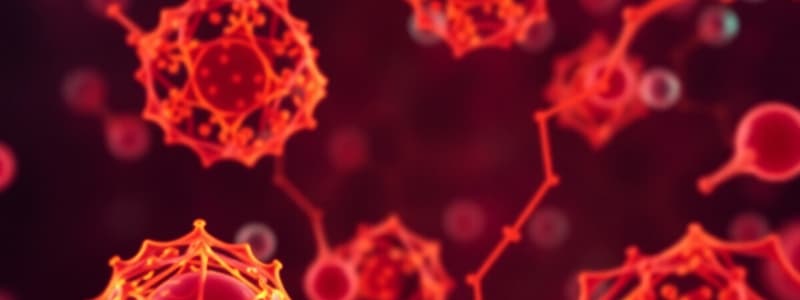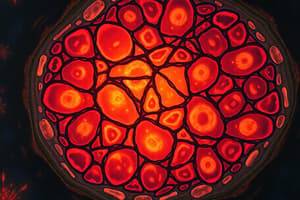Podcast
Questions and Answers
What is the primary characteristic that defines cancer?
What is the primary characteristic that defines cancer?
- Controlled cell growth
- Uncontrolled cell growth (correct)
- Cell death
- Normal cell division
What does malignancy refer to in the context of cancer?
What does malignancy refer to in the context of cancer?
- The mechanism of apoptosis in cells
- The potential to spread and invade nearby tissues (correct)
- The ability to undergo normal mitosis
- The stage of early tumor formation
Which factor is NOT associated with uncontrolled cell division leading to cancer?
Which factor is NOT associated with uncontrolled cell division leading to cancer?
- Balanced internal stimuli (correct)
- Disruption of normal cell cycle regulation
- Lack of homeostasis
- Response to external stimuli
Which statement best explains carcinogenesis?
Which statement best explains carcinogenesis?
What can be a consequence of uncontrolled cell division?
What can be a consequence of uncontrolled cell division?
What is the role of cyclins in cell cycle control?
What is the role of cyclins in cell cycle control?
How do cyclin-dependent kinases (cdks) become activated?
How do cyclin-dependent kinases (cdks) become activated?
What is the primary function of the active cyclin-cdk complex?
What is the primary function of the active cyclin-cdk complex?
What commonly happens to cyclins during the cell cycle?
What commonly happens to cyclins during the cell cycle?
What occurs when cdks are inactive?
What occurs when cdks are inactive?
What is the primary role of ubiquitin in the regulation of cyclins?
What is the primary role of ubiquitin in the regulation of cyclins?
Which protein complex is responsible for degrading short-lived proteins like cyclins?
Which protein complex is responsible for degrading short-lived proteins like cyclins?
What is one of the consequences of loss of cell cycle control?
What is one of the consequences of loss of cell cycle control?
What does MPF consist of in the context of cell cycle regulation?
What does MPF consist of in the context of cell cycle regulation?
What is the effect of MPF on the Anaphase promoting complex (APC)?
What is the effect of MPF on the Anaphase promoting complex (APC)?
Which of the following best describes the function of E3 ligases?
Which of the following best describes the function of E3 ligases?
What triggers the progression from G2 to M phase in the cell cycle?
What triggers the progression from G2 to M phase in the cell cycle?
What happens to the nuclear envelope during mitosis as a result of MPF activity?
What happens to the nuclear envelope during mitosis as a result of MPF activity?
What function does the p53 protein perform in cells?
What function does the p53 protein perform in cells?
Which statement is true about the TP53 gene?
Which statement is true about the TP53 gene?
What role do internal signals play at cell cycle checkpoints?
What role do internal signals play at cell cycle checkpoints?
What is a common effect of PDGF on fibroblast cells?
What is a common effect of PDGF on fibroblast cells?
Which checkpoint monitors the separation of sister chromatids?
Which checkpoint monitors the separation of sister chromatids?
Which factor is NOT a consideration for internal signals controlling the cell cycle?
Which factor is NOT a consideration for internal signals controlling the cell cycle?
What is the primary role of growth factors like PDGF in cell biology?
What is the primary role of growth factors like PDGF in cell biology?
Which of the following statements about p53 is true?
Which of the following statements about p53 is true?
What is density-dependent inhibition?
What is density-dependent inhibition?
What is anchorage dependence?
What is anchorage dependence?
How do normal mammalian cells behave when they form a complete layer?
How do normal mammalian cells behave when they form a complete layer?
What characteristic distinguishes cancer cells from normal cells?
What characteristic distinguishes cancer cells from normal cells?
What happens when normal cells are scraped away from a surface?
What happens when normal cells are scraped away from a surface?
Which statement regarding cancer cells is incorrect?
Which statement regarding cancer cells is incorrect?
Which of the following factors is NOT associated with normal cell division?
Which of the following factors is NOT associated with normal cell division?
What occurs in terms of cell proliferation in cancerous tissues?
What occurs in terms of cell proliferation in cancerous tissues?
What is the primary focus of precision oncology?
What is the primary focus of precision oncology?
Which checkpoint controls the transition from the G1 phase to the S phase in the cell cycle?
Which checkpoint controls the transition from the G1 phase to the S phase in the cell cycle?
What characteristic contributes to the heterogeneity of tumors?
What characteristic contributes to the heterogeneity of tumors?
Which of the following cellular components are involved in cell cycle regulation?
Which of the following cellular components are involved in cell cycle regulation?
What is a significant challenge in cancer treatment?
What is a significant challenge in cancer treatment?
Which checkpoint is responsible for controlling the transition through the stages of mitosis?
Which checkpoint is responsible for controlling the transition through the stages of mitosis?
How does precision oncology differ from traditional cancer treatment approaches?
How does precision oncology differ from traditional cancer treatment approaches?
What phenomenon describes the accumulation of different mutations within cancer cells?
What phenomenon describes the accumulation of different mutations within cancer cells?
Flashcards
Normal Cell Division
Normal Cell Division
When cells divide in a normal, controlled way, creating two identical daughter cells from one parent cell.
Uncontrolled Cell Division
Uncontrolled Cell Division
Uncontrolled cell division happens when cells keep multiplying without any regulation. This can lead to the formation of cancer.
Carcinogenesis
Carcinogenesis
This term refers to the overall process of cancer development and refers to a lack of homeostasis within the cells.
What is Cancer?
What is Cancer?
Signup and view all the flashcards
What is Malignancy?
What is Malignancy?
Signup and view all the flashcards
Cyclin-CDK complex
Cyclin-CDK complex
Signup and view all the flashcards
Cyclins
Cyclins
Signup and view all the flashcards
Cyclin-dependent kinases (CDKs)
Cyclin-dependent kinases (CDKs)
Signup and view all the flashcards
Phosphorylation
Phosphorylation
Signup and view all the flashcards
G1/S transcription factors
G1/S transcription factors
Signup and view all the flashcards
Cdk regulation
Cdk regulation
Signup and view all the flashcards
Proteasome
Proteasome
Signup and view all the flashcards
Ubiquitin
Ubiquitin
Signup and view all the flashcards
Ubiquitin ligases (E3 ligases)
Ubiquitin ligases (E3 ligases)
Signup and view all the flashcards
Unregulated cell proliferation
Unregulated cell proliferation
Signup and view all the flashcards
MPF
MPF
Signup and view all the flashcards
Anaphase Promoting Complex (APC)
Anaphase Promoting Complex (APC)
Signup and view all the flashcards
Nuclear Lamina
Nuclear Lamina
Signup and view all the flashcards
Density-dependent inhibition
Density-dependent inhibition
Signup and view all the flashcards
Anchorage dependence
Anchorage dependence
Signup and view all the flashcards
How do normal cells regulate growth?
How do normal cells regulate growth?
Signup and view all the flashcards
How do cancer cells differ from normal cells?
How do cancer cells differ from normal cells?
Signup and view all the flashcards
Characteristic of cancer cells
Characteristic of cancer cells
Signup and view all the flashcards
What does it mean when cancer cells lack density-dependent inhibition?
What does it mean when cancer cells lack density-dependent inhibition?
Signup and view all the flashcards
What does it mean when cancer cells lack anchorage dependence?
What does it mean when cancer cells lack anchorage dependence?
Signup and view all the flashcards
Why are density-dependent inhibition and anchorage dependence important?
Why are density-dependent inhibition and anchorage dependence important?
Signup and view all the flashcards
TP53 gene
TP53 gene
Signup and view all the flashcards
p53 protein
p53 protein
Signup and view all the flashcards
G1 checkpoint
G1 checkpoint
Signup and view all the flashcards
M phase checkpoint
M phase checkpoint
Signup and view all the flashcards
Apoptosis
Apoptosis
Signup and view all the flashcards
Growth factors
Growth factors
Signup and view all the flashcards
G2 checkpoint
G2 checkpoint
Signup and view all the flashcards
Internal signals
Internal signals
Signup and view all the flashcards
What are the characteristics of cancer cells?
What are the characteristics of cancer cells?
Signup and view all the flashcards
Why are cancer cells so challenging to treat?
Why are cancer cells so challenging to treat?
Signup and view all the flashcards
What is precision oncology?
What is precision oncology?
Signup and view all the flashcards
What are the key cell cycle checkpoints?
What are the key cell cycle checkpoints?
Signup and view all the flashcards
What are cyclin-dependent kinases (CDKs)?
What are cyclin-dependent kinases (CDKs)?
Signup and view all the flashcards
What are cyclins?
What are cyclins?
Signup and view all the flashcards
How do cyclins and CDKs work together?
How do cyclins and CDKs work together?
Signup and view all the flashcards
What role does phosphorylation play in cell cycle regulation?
What role does phosphorylation play in cell cycle regulation?
Signup and view all the flashcards
Study Notes
Cell Cycle Regulation
- Cell cycle control is crucial for normal cell function and preventing diseases like cancer
- The cell cycle is a series of events that lead to cell duplication, involving checkpoints for regulation
- Learning objectives include understanding cell cycle control, checkpoints, the role of cyclin-cdks, tumor suppressor genes (Rb and p53), and cdk inhibitors (CKIs)
- Cancer is characterized by uncontrolled cell growth, proliferation, and potential metastasis
- Learning the difference between benign and malignant tumors is key
- Recommended reading includes chapters 12 of Campbell Biology and 17 of Alberts et al.'s Molecular Biology of the Cell (2008 7th Edition)
Phases of the Cell Cycle
- The cell cycle consists of interphase (G1, S, and G2 phases) and the mitotic phase (M phase) which includes mitosis and cytokinesis
- Interphase: the period of growth and DNA replication before mitosis
- G1 phase: cell growth and preparation for DNA replication
- S phase: DNA replication occurs
- G2 phase: final preparation for cell division
- Mitotic phase (M phase): the division of the nucleus and cytoplasm
- Mitosis: nuclear division
- Cytokinesis: cytoplasmic division
Importance of Cell Cycle Regulation
- Cell division must be tightly controlled
- Uncontrolled cell division leads to carcinogenesis
- Homeostasis in normal tissue is maintained by the balance between mitosis (creation of new cells) and apoptosis is death of cells
- Imbalance results in disease
- Understanding cell cycle regulation is essential to understand how and why cancer occurs
What is Cancer?
- Cancer is uncontrolled cell growth
- Abnormal cell growth, proliferation, and often metastasis
- Characterized by the loss of cell cycle checkpoints and controls
Carcinogenesis
- Cancer development involves environmental and genetic predisposition
- Carcinogens are substances that can lead to cancer, categorized as chemical, physical, and viral
- Mutations leading to uncontrolled proliferation and inhibited apoptosis contribute to carcinogenesis
- Activation of oncogenes and inactivation of tumor suppressor genes are key factors in carcinogenesis
Cell Cycle Checkpoints
- Checkpoints are control points in the cell cycle to ensure proper progression
- G1 checkpoint: evaluates cell size, correct DNA, nutrients and factors before DNA replication
- G2 checkpoint: ensures that DNA replication has been properly completed and any damage is repaired
- M checkpoint: verifies correct chromosome attachment to mitotic spindle before separation
G1 Checkpoint
- Checks for cell size, nutrients, growth factors and DNA damage
- If conditions favorable, the cell commits to entering the S (DNA replication) phase
G2 Checkpoint
- Monitors if the DNA replication is complete and free of damage before mitosis
- Ensures accurate DNA replication before cell division
- Regulates the transition from G2 phase to M phase
M (Metaphase) Checkpoint
- Checks for accurate chromosome alignment on mitotic spindle for correct chromosome segregation during mitosis
- Prevents the separation of sister chromatids if alignment is incorrect
Molecules for Cell Cycle Control
- Cyclins and cyclin-dependent kinases (Cdks) are crucial parts of the cell cycle control system
- Cdks are present at a constant concentration to maintain control of the cycle. They only become active upon binding to cyclins
- Cyclins fluctuate in concentration, activating and inactivating Cdks.
- The activity of Cdks is regulated by the proteasome, which targets cyclins for degradation.
- Tight regulation of Cdks is imperative to normal cell function, loss of regulation triggers unregulated cell proliferation and carcinogenesis
Cell Cycle Regulation by Cyc-Cdks
- Different classes of cyclins associate with distinct classes of Cdks at different times in the cell cycle to regulate the phases.
- (Early G1), (Late G1), (S phase), (G2/M phase)
Cell Cycle Regulation by Tumor Suppressor Genes
- Crucial for controlling cell growth and preventing uncontrolled cell proliferation
- Examples include RB1 and TP53 -RB1: involved in controlling the progression from G1 to S by controlling E2F
- TP53: called the "guardian of the genome" plays a role in DNA repair and apoptosis to prevent damaged cells from dividing.
Internal and External Signals
- Internal signals, such as cell size and chromosome alignment, trigger checkpoints
- External signals, like growth factors, allow cell-to-cell communication and promote cell division
- Signals trigger cell cycle progression via specific signaling pathways
External Signals
- Growth factors promote cell division
- Density-dependent inhibition: crowded cells stop dividing, ensuring cells don't excessively proliferate
- Anchorage dependence: animal cells must attach to a surface to divide
Cancer Cells: Loss of Cell Cycle Control
- Cancer cells do not respond to density-dependent inhibition or anchorage dependence
- They make their own growth factors, keep the growth promoting signaling pathways turned "on", and demonstrate abnormal cell cycle control
- Benign tumors: not invasive, contained at the site of origin
- Malignant tumors: invasive, can spread to other organs
Malignant Tumors
- Malignant tumors invade surrounding tissues and spread (metastasis)
- Key characteristics include uncontrolled proliferation and loss of cell cycle checkpoints, allowing for cancer spread
Precision Oncology
- This is the science of using a patient's genetics to tailor treatment plans for cancer
- Aims to target the specific molecular characteristics of the cancer, ensuring effective and efficient treatment
Studying That Suits You
Use AI to generate personalized quizzes and flashcards to suit your learning preferences.




